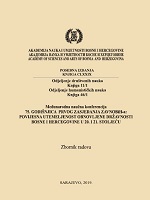NA PUTU OD AVNOJ-A DO ZAVNOBIH-a, HISTORIJSKA MJESTA I DINAMIKA SJEĆANJA
ON THE ROAD FROM AVNOJ TO ZAVNOBIH, HISTORICAL PLACES AND DYNAMICS OF MEMORIES
Author(s): Jasna Pašić
Subject(s): Political history, WW II and following years (1940 - 1949), History of Communism, Fascism, Nazism and WW II, Politics of History/Memory, Wars in Jugoslavia
Published by: Akademija Nauka i Umjetnosti Bosne i Hercegovine
Keywords: AVNOJ; ZAVNOBIH; Memory; Antifascism; Bosnia and Herzegovina; Statehood;
Summary/Abstract: The historical decisions made at the assembly of AVNOJ and ZAVNOBIH, regardless of the socio-political context of their interpretation, represent permanent values of anti-fascist voices from Bosnia and Herzegovina at the midst of World War II. These were the steps that preserved the inner being of Bosnia and Herzegovina and the connection of its all centuries old symbols. The dynamics of memories and public perception of significant dates have been altered due to changes in the value of the political framework in the socialist and post-socialist period. In the case of AVNOJ and ZAVNOBIH, different treatment of events can be seen related to state holidays. The Yugoslav culture of memory included all segments of society, in order to shape the formative forces of the desired articulation of remembrance. The historical places are shaped in places of memory, in which deep symbolic connections. Such is an example can be followed Bihać, Mrkonjić-Grad and Jajce, as well as the events which have been organized for the purpouse of among anniversaries in these cities. State holidays and commemorative dates were in the crisis during the time dissolution of Yugoslavia and in clash of overall legacy of communism. In the period of democratic changes, the coarse selection, partial or complete rejection and denial has occurred. AVNOJ’s current socio-political context has become completely useless, while ZAVNOBIH has been perceived in three ways in the 1990s in Bosnia and Herzegovina. The ethnic divisions after the Dayton Peace Agreement have resulted in the relativization and denial of anti-fascist legacy and the identity of Bosnia and Herzegovina. The public monuments and spaces related to this were abused in order to deepen the national divisions and disrupt the idea of equality of citizens and nations, which was achieved 75 years ago. In this case, it is not just about transforming memories, but about undermining universal civilizational values in order to strengthen nationalisms. Such a relationship to the AVNOJ and ZAVNOBIH and their significance for Bosnia and Herzegovina points to a serious crisis of democratic values.
- Page Range: 291-304
- Page Count: 14
- Publication Year: 2019
- Language: Croatian
- Content File-PDF

